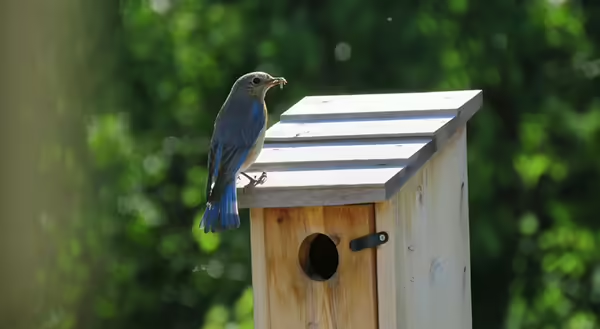
By Joe Huether, Illinois Extension Master Naturalist serving Fulton, Mason, Peoria, and Tazewell counties
For as long as I can remember, I’ve been drawn to the naming of things. As a kid, gazing through the window of the family van, I’d watch the scenery change as we flew past: subtle shifts of green in trees, a blaze of roadside flowers, the amorphous, earthy tones of perched birds on fence posts and telephone wires. The older I got, and the more interested I became in what my world was made of, I learned what names to put to the shapes I saw. That undefined swirl of color and shadow became sugar maple and cottonwood, showy goldenrod and white wild indigo, American kestrel and the busy eastern bluebird. The more I learned, and the more I could name, the more it felt like the world was opening itself up and inviting me in.
Those long drives and hours of window-gazing lead me here, to July 2024, serving my first summer as a bluebird steward at Tawny Oaks. Something about those words, bluebird steward, strung together like almost-rhyming pearls, fascinated me when I first heard them, and continue to fascinate me as I consider my role each week in the park. Put simply, my task is to monitor the population and help maintain the conditions these creatures require to thrive.
On our best days, I think, to live is to observe and absorb, to learn, and apply these observations in creative ways to our own lives. So, what have I learned in this time on the trail?
A female bluebird will lay her pale blue eggs, usually 3-6 at a time, in a cup-like nest she weaves from strands of stolen grass, pine needles, and occasionally the hair or feathers of other animals. Any good field guide will tell you that. But what I hadn’t read was that sometimes a mother bluebird, so dedicated to her task, won’t budge an inch, even when the end of a smartphone slides through the opening of her house to snap a picture of what’s inside. That’s amazing dedication when you think about it from her perspective!
Caring for bluebirds in this way has an obvious ecological benefit. By monitoring these boxes, I’m contributing to the success of the species overall, even if my presence is annoying to these diligent creatures as they go about the heavy business of survival. But stewarding has offered me something else: a feeling of being grounded, of belonging to a place, and a deeper connection to the landscape I’m lucky to call home.
Visiting the park each week and engaging with it hands-on has been like finding a door into the world I didn’t know I had access to, even though it’s always been there.
So, what have I learned? To visit this park, any park, as often as I can. Witness what the landscape offers, learn to name the shapes I find, explore. The invitation always stands. The world is open and waiting for me, for anyone, to step inside.
Photo credit: eastern bluebird with caterpillar Image by Nyles McNierney from Pixabay